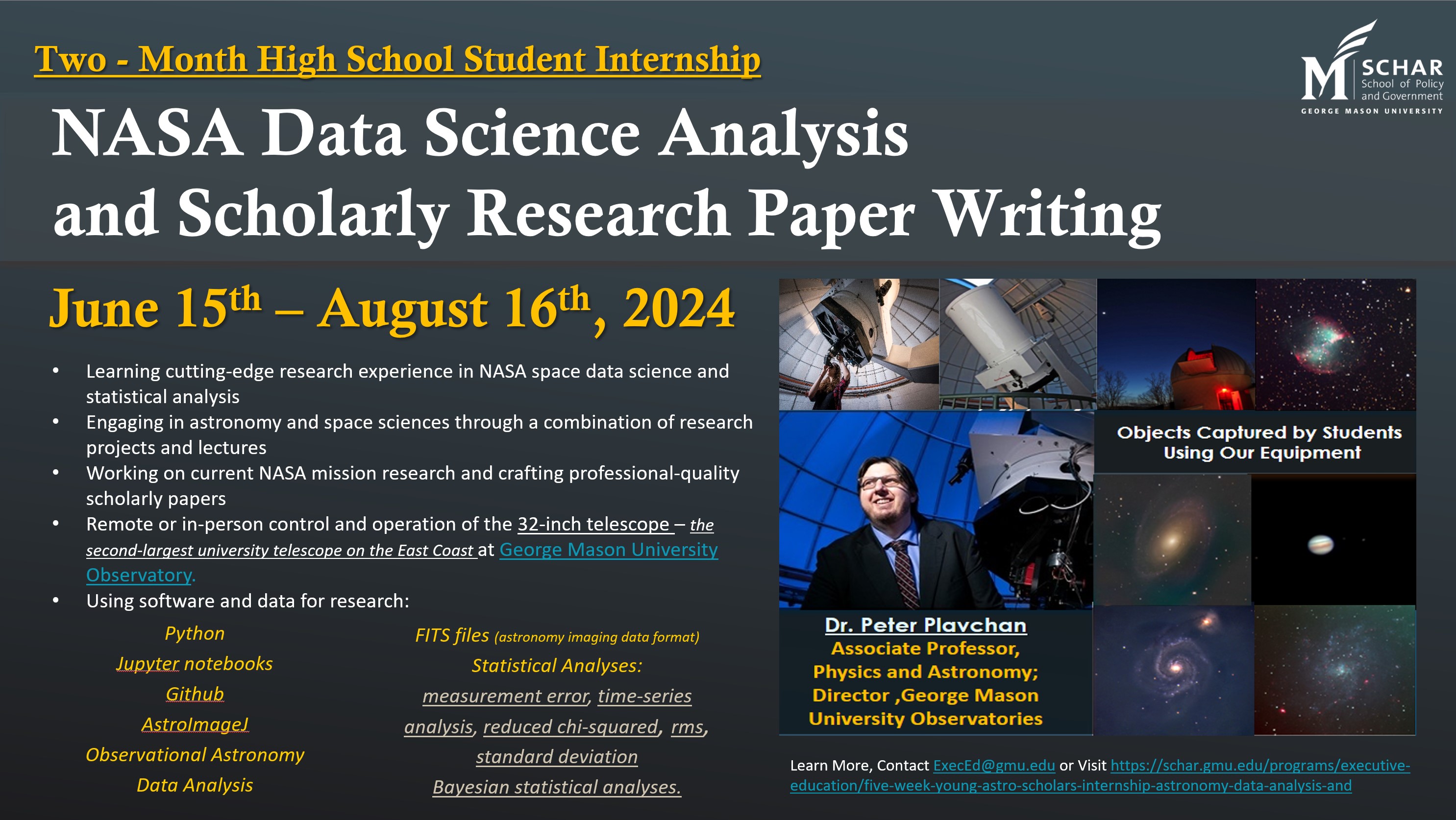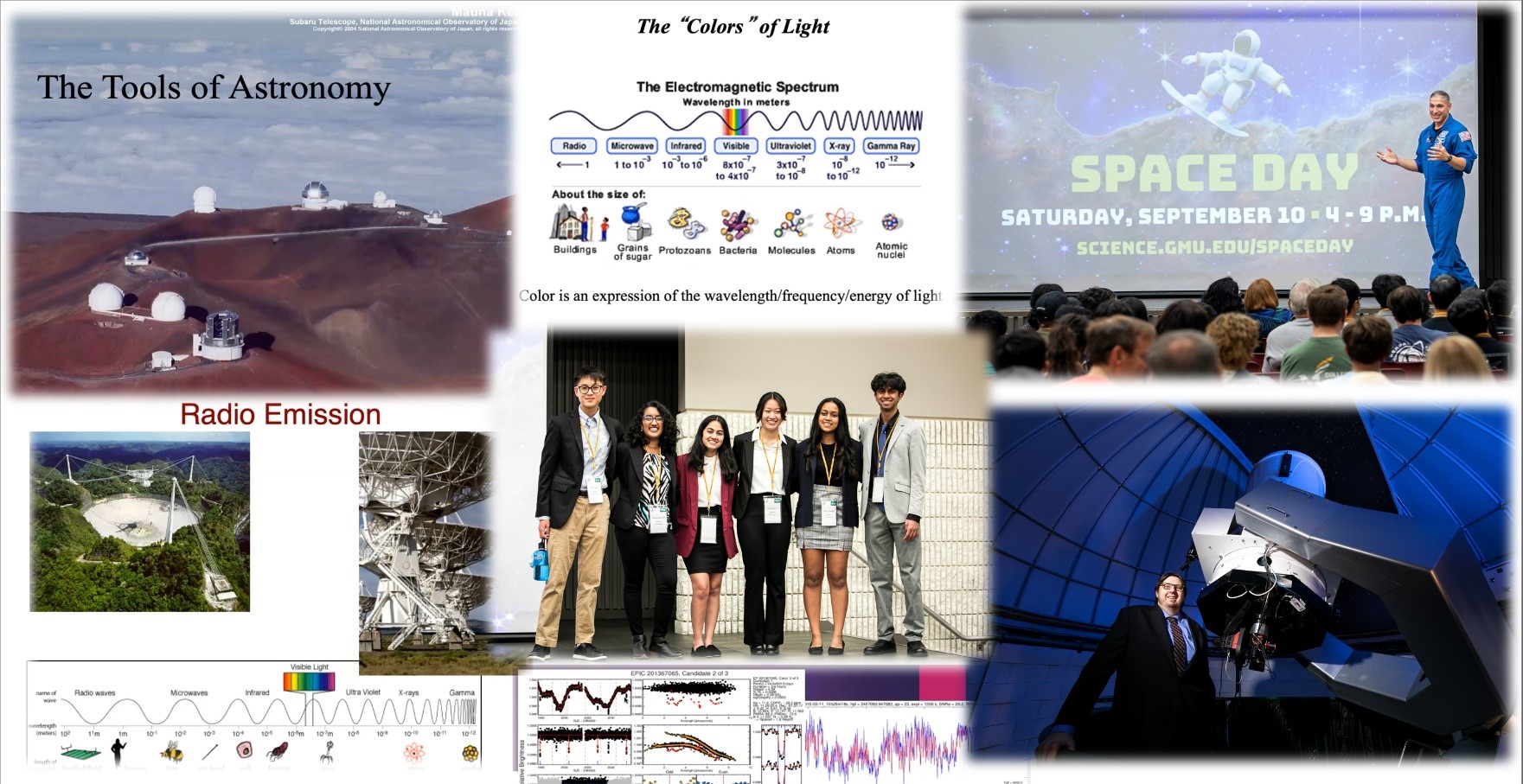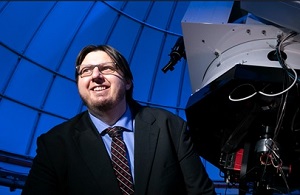Exciting News
NASA Summer 2023 Participant Named Regeneron Science Talent Search 2024 Finalist
We wanted to share some exciting news about one of our outstanding NASA Summer 2023 program participants. David Lu Cao has been selected as one of the finalists for the prestigious Regeneron Science Talent Search 2024.
David's remarkable achievement reflects not only his dedication to scientific inquiry but also the high caliber of participants in our program. We are immensely proud of his accomplishment and delighted to showcase the success of our program's participants.
You can find more details about David's recognition on the Regeneron webpage: Regeneron Science Talent Search 2024 Finalists.
Summer 2024 Program
Department of Physics and Astronomy
College of Science and Schar School of Policy and Government
George Mason University
Location: Hybrid (primarily virtual, with in-person options at the GMU Fairfax Campus)
Course Dates: June 15th 2024- August 5th, 2024
The internship program consists of:
- Three Synchronous Virtual meetings on Saturdays 1:00 pm to 3:00 p.m. EST; 10:00 a.m. - 12:00 a.m. PST;
- June 15th - Opening; Introduction of the Research Program; Assigning Observing Sessions
- June 22nd - Lecture and Research Project Selection
- June 29th - Lecture and Research Project Feedback
- Three asynchronous study and lecture sessions on Tuesdays: June 18th, June 25th, July 2nd. Our faculty team will release a recording of project instructors each week based on students' research progress.
- Small group nighttime virtual telescope observing sessions: June 17th through June 30th by RSVP
- Five weeks Research Project Analysis and Paper Writing Period with optional group discussions via Discord communications platform. July 2nd – August 16th; The faculty team will work closely with students to help them finalize their research paper for publication at the Schar School Young Scholars Journals Webpage.
- Research Paper presentation/conference day – Optional hybrid in person and virtual; August 5th
Registration
- We can only accept 50 students this summer. Available seats are on a first-come, first-served basis.
- Please email execed@gmu.edu for application and program fees.
- Need-based scholarships are available.

Certification
Upon program completion, students will receive a Certificate of Completion from George Mason University. Students will also have the benefit of having their research paper posted on the official George Mason University webpage see Schar School Young Scholars Journals Webpage.
Program Summary
The Young Scholars NASA Data Science Analysis and Research Paper Program offers students an engaging and authentic professional, cutting-edge research experience in NASA space data science and statistical analysis. This dynamic and immersive virtual summer initiative is tailored for ambitious high school students seeking exciting and challenging opportunities in STEM. Participants will engage in a comprehensive program delving into astronomy and space sciences through a combination of research projects and lectures. Working collaboratively on current NASA mission research, students receive guidance on crafting professional-quality scholarly papers to enhance their research and communication skills.
This year's research projects will first encompass analysis of a subset of the 6000+ current NASA TESS mission exoplanet candidates and second James Webb Space Telescope data analysis. The TESS candidates have been manually vetted after being identified by the NASA TESS mission automated search algorithms. However, they still require follow-up observations, detailed analysis, and data synthesis to evaluate the statistical probability that they are genuine exoplanets, not false positives such as nearby eclipsing binary star systems. The NASA TESS mission requires a community follow-up program to aid in validating these candidates. The primary instructor is a main contributing Principal Investigator to the official NASA TESS follow-up program and has contributed to the statistical validation and/or confirmation of over fifty of these worlds (confirmation requires mass detection through a second exoplanet detection technique).
Students will be introduced to and then apply professional tools and statistical techniques to perform this professional and cutting-edge follow-up analysis. Each student will contribute to the professional statistical validation of a unique exoplanet candidate by directly collecting, analyzing, and synthesizing novel follow-up observations. This work will be in direct support of the official NASA TESS mission exoplanet candidate follow-up program. Each exoplanet candidate is different –different planetary properties and different probabilities of statistical and astrophysical false-positive signals. The outcome of the students analysis will aid the NASA TESS mission in determining which of its candidates are the result of genuine orbiting exoplanets. View the Transiting Exoplanet Survey Satellite (TESS) website, and the TESS Follow-Up Observing Program (TFOP) website for more information, and the article, NASA’s TESS, Spitzer Missions Discover a World Orbiting a Unique Young Star, for an example NASA discovery made by the primary instructor.
Second, the James Webb Space Telescope launched two years ago, and one of its primary science applications is the follow-up characterization of NASA TESS mission candidates to attempt to measure the atmospheric properties through spectroscopy of a subset of these worlds – about 50 to date – that we have statistically validated and/or confirmed. NASA mission data has limited or zero proprietary data periods and are available to the public. However, transforming the raw data into usable scientific products is a challenging task. Advanced students will optionally download and analyze these data sets to produce spectral time-series which require advanced modeling to extract the atmospheric spectra.
Noteworthy program highlights include:
- Engaging with experts comprised of astronomy specialists from NASA and across the globe.
- Remote or in-person control and operation of the 32-inch telescope at George Mason University during group observation nights. This is the second-largest university telescope located on the east coast. You can observe students utilizing the George Mason University Observatory.
- Becoming experts on a chosen exoplanetary system by gathering data on observation nights and from the NASA TESS and JWST missions, analyzing and synthesizing this data during research. Each student will choose a unique system for which they will explore and analyze.
- Crafting individual professional quality scholarly papers based on the data they collect, with guidance from George Mason faculty. The aim is to produce papers suitable for student competition submission and in some cases suitable for publication in a professional journal.

Dr. Peter Plavchan will be the primary instructor to lead and work with teams of scientists from around this world to search for other worlds, or exoplanets, including those that are potentially habitable and Earth-like. The National Academies of Science, Engineering and Medicine once a decade survey of astrophysics has recommended a future NASA flagship mission to directly image and characterize the nearest Earth-like worlds to the Sun. This mission is now under development and called the Habitable Worlds Observatory. It will launch in the 2040s, and the “billion dollar question” is whether or not we will know beforehand which stars host these Earth-like worlds, or if this mission will also have to search for them. Thirty years ago, the existence of other worlds was science fiction, and today over 5500 other worlds are known, many unlike anything in our Solar System. Dr Plavchan will teach you how we find these worlds, what we know about them, and how we will find “Earth 2.0”. Learn more about Peter’s research group and watch students are exploring the Universe from The George Mason University Observatory.
During this program, students will be participating in a guided astronomy-based research project applying some of the following methods, including but not limited to:
- Astronomy data analysis on NASA missions
- Observational astronomy and statistical analysis.
- Quantitative Research
- Scientific methods of inference
- Observational data collection and management
- Statistical science inference
- The private space revolution and its impact upon astronomy and space policy
By using the following software and data for research:
- Python
- Jupyter notebooks
- Github
- AstroImageJ
- Observational Astronomy Data Analysis
- FITS files (astronomy imaging data format)
- Statistical analyses such as measurement error, time-series analysis, reduced chi-squared, rms, standard deviation and Bayesian statistical analyses.
Project Presentation Conference on August 5th, 2024
On Friday, August 5th, 2024, students will have the exciting opportunity to present their research papers at George Mason University. For those coming from out-of-state, a hybrid option is also available. The conference not only serves as a platform for showcasing research projects but also provides a competitive edge, as teams can vie for awards and scholarships offered through the Experimental NASA Data Analysis and Space Research Scholarly Paper Writing Young Scholars Program. As an added benefit, all program participants will receive two tickets, allowing them to extend invitations to family or friends to attend the conference. The National Space and Data Analysis Board (NSDAB) guarantees an exceptional experience, supporting students in honing their presentation skills and showcasing the knowledge acquired during the Young Scholars program. It's an enriching opportunity for students to shine and share their passion for space and data analysis.
Keynote Speaker
TBA
About the Instructor

Dr. Peter Plavchan is an Associate Professor of Physics and Astronomy at George Mason University, and the Director of the George Mason University Observatories. He earned his undergraduate degree in Physics at Caltech in 2001, his PhD from UCLA in 2006, and he has held appointments at the NASA Exoplanet Science Institute at Caltech, Missouri State University, and a visiting appointment at the University of Pennsylvania.
Dr. Plavchan is an observational exoplanet astronomer, with a focus on the formation and demographics of planets around cool dwarfs, utilizing the radial velocity and transit detection methods. He has led a number of NASA mission concept studies, is the PI of a pending NASA cubesat mission proposal, is a Co-PI of the MINERVA and MINERVA-Australis telescope arrays, regularly uses the NASA Transiting Exoplanet Survey Satellite and NASA Infrared Telescope Facility iSHELL spectrometer for exoplanet discovery, has served as an Executive Committee member of the NASA Exoplanet Program Analysis Group (ExoPAG), and has received multiple NASA Group Honor Achievement Awards. His research is currently supported by NASA, NSF, and the Mt. Cuba Astronomical Foundation, and his work has appeared in numerous local and national publications and media including CNN and Fox News.
